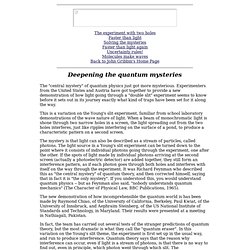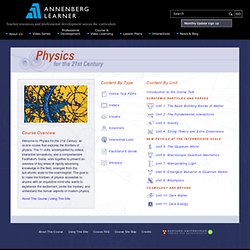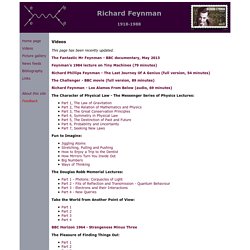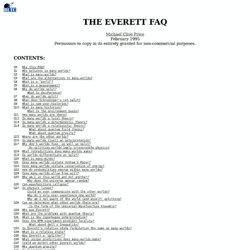

Mozilla Firefox Start Page. Quantum mysteries. John Gribbin For seventy years, physicists have worried about what quantum mechanics means.

They can use quantum physics, to be sure; witness the successful designs of lasers and computer microchips, and the understanding of molecules that makes genetic engineering possible. But the equations that are a routine part of this kind of work contain one embarrassing feature. The say, according to the standard interpretation (the Copenhagen interpretation), that nothing is real unless you look at it, that an electron (say) exists only as a wave of probability, called a wave function, which collapses into reality when it is measured, and promptly dissolves into unreality when you stop looking at it.
We are no further advanced philosophically, on this picture, than the image of the tree in the quad which disappears when nobody is looking at it. In fact, few physicists worry about such things. So far, simple enough. It works like this. Math, Physics, and Engineering Applets. Oscillations and Waves Acoustics Signal Processing Electricity and Magnetism: Statics Electrodynamics.

The Higgs Boson Explained. Invisible dark matter skeleton of universe detected - Phenomenica. - StumbleUpon. A Theory on the Deja Vu or Déjà vu Phenomenon During the time while this web-page has been on the Internet, more than three thousand people (up to Nov 2009) have e-mailed to say that they have Déjà Vu experiences.

That is interesting, but their descriptions have virtually always described some different phenomenon. If a person has any pre-knowledge of something that is yet to happen, like in a dream, it cannot be Déjà Vu, and is likely to be some type of Precognition. (Even if the Precognition is only a few seconds before the event.) A person cannot know that a Déjà Vu experience is coming, and also, it is also always sensed as INSTANTANEOUS, as being a sudden realization that an experience "was somehow familiar".
This last part effectively eliminates credible Deja Vu from occurring in any place that the person has already been! Heisenberg / Uncertainty Principle - Werner Heisenberg and the Uncertainty Principle. Physics for the 21st Century. Course Overview Welcome to Physics for the 21st Century: an on-line course that explores the frontiers of physics.

The 11 units, accompanied by videos, interactive simulations, and a comprehensive Facilitator's Guide, work together to present an overview of key areas of rapidly-advancing knowledge in the field, arranged from the sub-atomic scale to the cosmological. HPS 0410 Einstein for Everyone. Title page, Preface and Table of Contents for Einstein for Everyone Introduction: the Questions Special Relativity Special Relativity: the Principles Special Relativity: Clocks and Rods Special Relativity: Adding Velocities.

The Feynman Lectures on Physics Website. Quantum Mechanics Explained. Richard Feynman videos. Videos This page has been recently updated.

The Fantastic Mr Feynman - BBC documentary, May 2013 Feynman's 1984 lecture on Tiny Machines (79 minutes) Physics Documents. The Strong Force for Beginners. “I found I could say things with color and shapes that I couldn’t say any other way — things I had no words for.”

–Georgia O’Keeffe When it comes to the Universe, it isn’t just the stuff that’s in it that’s important. Image credit: 2MASS Extended Source Catalog (XSC). It’s also how all that stuff interacts with itself and everything else. To the best of our knowledge, there are four fundamental forces in the Universe, and they’re all essential to our existence. Image credit: Stichting Maharishi University of Management, the Netherlands. Some of them are familiar, like gravitation. Image credit: Mark Garlick / SPL. There’s no “anti-mass” or “anti-energy” that causes some objects to be gravitationally repelled while others are gravitationally attracted. But other forces and interactions can be more complicated than gravity in this regard. Image credit: copyright 2012. Image credit: Science Photo Library. We even understand, at a fundamental quantum level, how this works.
Lectures. The Transactional Interpretation of Quantum Mechanics. John G.

Cramer This paper was originally published in Reviews of Modern Physics 58, 647-688, July (1986). It is copyrighted (©1986) by John G. Cramer and the American Institute of Physics and may not be reproduced without permission. Reproduction of single printed copies for personal non-commercial use is authorized. The Everett Interpretation. This FAQ shows how quantum paradoxes are resolved by the "many-worlds" interpretation or metatheory of quantum mechanics.

This FAQ does not seek to that the many-worlds interpretation is the "correct" quantum metatheory, merely to correct some of the common errors and misinformation on the subject floating around. As a physics undergraduate I was struck by the misconceptions of my tutors about many-worlds, despite that it seemed to resolve all the paradoxes of quantum theory . The objections raised to many-worlds were either patently misguided or beyond my ability to assess at the time , which made me suspect (confirmed during my graduate QFT studies) that the more sophisticated rebuttals were also invalid.
I hope this FAQ will save other investigators from being lead astray by authoritative statements from mentors. I have attempted, in the answers, to translate the precise mathematics of quantum theory into woolly and ambiguous English - I would appreciate any corrections. 4) [M]. Personal and Historical Perspectives of Hans Bethe. Sys-metrology-248-434.pdf. Free physics Animations- Learnerstv. Natural Philosophy/ Physics and Quantum Mechanics.